To get started you will need a fresh roll of 120 film, two old metal 620 reels which are just a little smaller than the modern plastic 120 reels, and a dark film changing bag which is normally used for daylight loading of film into sheet-film holders or developing cannisters.
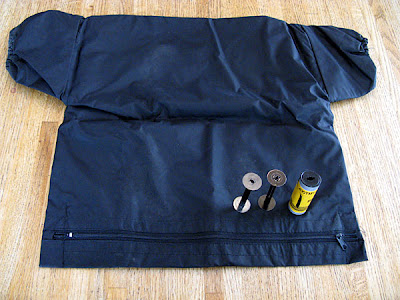
Peel off the paper retaining strip from the film roll and insert the tapered end of the backing paper squarely into the longest slot in the first 620 reel. Roll enough of the backing paper onto the reel so that it will all stay in place when you lay it down inside the dark bag. Now, place everything including the second empty 620 reel inside the bag, zip it up and put your hands in through the elastic-cuffed sleeves of the bag. Everything from here on is done in total darkness.
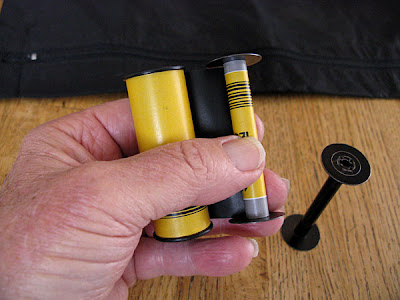
Take up the slack and start rolling the backing paper further on to the 620 reel. Maintain some tension with your fingers on both reels so that the film winds on smoothly but do not use excessive force which could damage the film emulsion. If you feel uncertain about the process, it would be worthwhile to sacrifice a roll of film to practice the procedure in daylight once to get the feel of it.
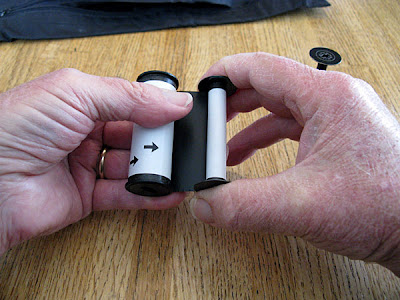
After you have rolled about a foot of the backing paper onto the 620 reel you will come to the beginning of the actual film with is attached to the backing paper with a strip of tape. Just keep right on, smoothly rolling the backing paper and attached film onto the 620 reel.
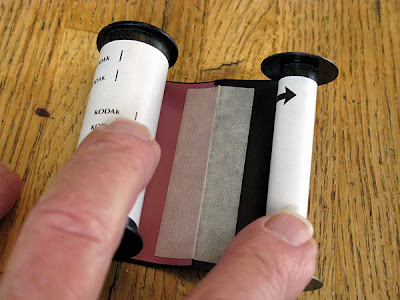
When you get to the end you will have another retaining strip hanging off the end of the backing paper which is normally used to secure the roll after you have removed it from the camera. I generally just leave that alone, though you could tear it off at that point and just use a rubber band to secure the roll if necessary until it is processed.
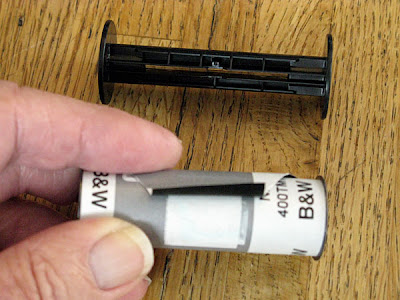
Set aside the plastic 120 reel, pick up the second empty 620 reel and thread the tapered end of the backing paper into the long slot as before. You should be able to distinguish the long slot from the short one by running your fingertip along the shaft of the reel. Be sure the paper is squarely centered in the reel and start winding again while maintaining some tension.
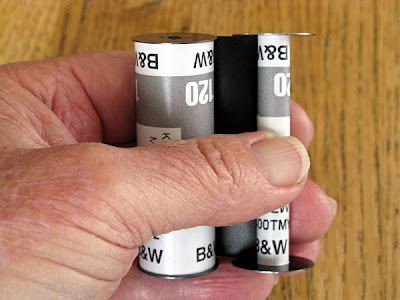
You will soon come to the end of the film which is free and not taped to the backing paper as is the other end. You may not immediately detect the film end, but you will feel the stiff and slick surface as distinct from the backing paper. You will need to tuck the free end of the film under the rolled backing paper, and then continuing rolling on, maintaining appropriate tension.
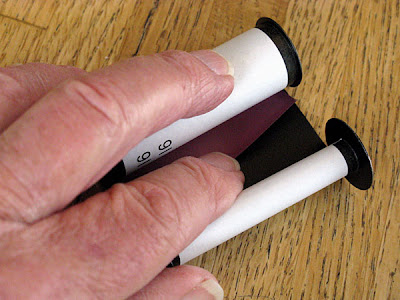
About a foot from finishing, you will again encounter the end of the film that is taped onto the backing paper. At this point, some people recommend carefully peeling off the tape and repositioning it to remove any buckling of the film that has been created by the rolling process. I have not found that to be necessary, possibly because the use of two 620 spools in the process seems to avoid the buckling problem.
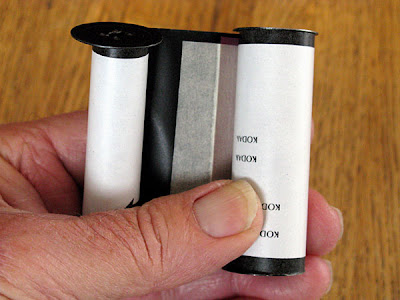
Continue rolling on the film and backing to the end and you have your roll of film ready for loading into your 620 camera. If you need to store the film, put a rubber band around the roll to keep it secured, and store it in a dark container. If you are going to have someone else process your film, be sure to tell them that you need to get your 620 reel back with the negatives.
I continued for a time to use trimmed 120 reels in my cameras which would permit that. However, the rerolled film on 620 reels tends to advance much more smoothly in any of the cameras designed for the format, and I now use only the rerolling method.

11 comments:
Thanks for the two 620 reels technique! I'm waiting for the 620 reels I just purchased to use for my Argus Seventy Five and will definitely this re spooling method. Thank again!
Getting the 120 film onto a 620 reel is really easier to do than to explain. Good luck with it, and show me some pictures from that Argus Seventy Five.
Hi I'm Jessica from Italy-Venice. I've a Kodak duaflex II camera, I've follow your device for change a 120 film' spool. But it don't work, maybe the error is my. Could you give me some more advise about this particular camera? Maybe are there some more detail to know about it?
Thanks so much,
best wishes
Jessica
Hi, Jessica.
The Duaflex was built to use 620 film with spools that are slightly shorter and smaller in diameter than currently available 120 film. The least costly way to deal with this situation is to re-roll the film and backing from a new 120 reel onto an old 620 metal spool which will fit in the camera. You will also need to have another 620 reel in the take-up position to receive the film as it is used in the camera.
If you are having difficulty with the process of re-rolling, then it might be worthwhile to get some modern 620 film which can still be obtained in a few places. For instance, you can buy 620 color or b&w Kodak film B&H Photo Video (http://www.bhphotovideo.com/c/buy/110-127-620-828/ci/336/N/4294540487).
HI Thanks so much!
I've just heard about your store......and I think it is so cool!!
Thanks, again, for your suggest.
Good bye
Best wishes
I have the early (art deco) Duo Six-20 and feel lucky that all I need to do is grab a pair of large nail clippers and trim the edges off to use 120. Though the length is a bit tight it still fits without any forcing.
I'm wondering if they changed specifications on it for the later models.
Rich L
That might be the case. I recall that Mike Elek told me he could get trimmed 120 in his Duo 620. I couldn't seem to do it in mine -- probably needed a bigger hammer. Actually, though, even in the cameras which will permit the use of the trimmed spools, I still prefer to use re-rolled film as it is easy to do, and it goes through the camera more smoothly.
Good point about the smoother turning. With the wider slot of the 120 spool I think there's a bit of a cam action as the spool flops while turning.
Right now I have enough fun slitting and spooling film for my Minox so I'll live with the trimmed 120 for the time being.
I recall someone suggesting that stuffing some bits of toothpick in the spool ends would help to keep the spool from flopping around. I probably should have tried that on my Kodak Monitor. I was able to fit a trimmed 120 spool into the supply side, but when I wound the film the spool would bind. I ended up adapting the film holder from a Billy Record to use in the Monitor, which works ok.
All of this is to put 120 film onto a 620 spool. But how to you go backwards and put the film back onto the 120 spool? A camera store said they could develop my 620 film if I respooled it onto a 120 spool. Is it the same, just going backwards?
Sorry to come back with a late reply; don't know how I missed this question. The answer is "yes". That is, you can roll off the film onto a 120 spool if that is the only way your processor will accept the job. It does seem like a lot of extra trouble, though. I think I would likely try to find someone else to process my film.
Of course, the other possibility is to develop the film yourself. I don't do color film myself, but home processing of black-and-white is really not difficult; it just requires that some care be taken in regard to developing and fixing time and controlling the temperature of the solutions.
Post a Comment